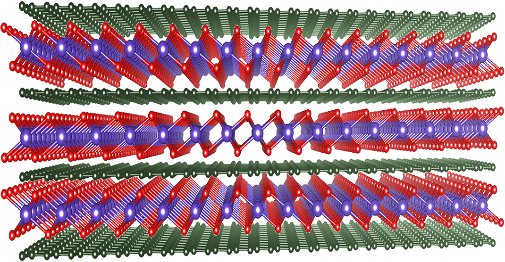 Press Release 2018
Press Release 2018
Development of an Oxide/Graphene Composite to Increase the Capacity and Life of Rechargeable Batteries
- Breakthrough in Alternating Nanosheet Stacking -
A NIMS research group synthesized a composite material composed of stacked, alternating nanosheets of manganese oxide (MnO2) and graphene and used it as an anode material for lithium and sodium ion batteries. The charge/discharge capacity of these batteries was more than double that of conventional batteries with MnO2/graphene composite anodes. In addition, the cycle life of these batteries increased substantially.
(“Genuine Unilamellar Metal Oxide Nanosheets Confined in a Superlattice-like Structure for Superior Energy Storage,” Pan Xiong, Renzhi Ma, Nobuyuki Sakai, and Takayoshi Sasaki; ACS Nano, 2018, 12 (2), pp 1768–1777; DOI:10.1021/acsnano.7b08522)
To increase the capacity of rechargeable batteries, a great deal of battery research has focused on the use of transition metal oxides due to their high theoretical capacity to serve as alternatives to the carbon-based anode materials currently in use. It had been thought that the anode capacity of MnO2 could be greatly increased by separating it into single-layer nanosheets, thereby increasing the surface area on which active sites are present. However, MnO2 nanosheets are prone to clumping together into a mass and susceptible to structural degradation when subjected to repeated charge/discharge cycles .
In this research project, we synthesized a composite material composed of alternately stacked single-layered MnO2 nanosheets and graphene (Figure 1). Although both MnO2 and graphene are negatively charged and thus repel each other, we were able to alternately stack nanosheets of these compounds by chemically modifying negatively charged graphene nanosheets into positively charged graphene derivative nanosheets using a technique we developed in 2015. Suspensions of MnO2 nanosheets and graphene derivative nanosheets were then simply mixed and the synthesized material was used as an anode for lithium and sodium ion batteries. The resulting lithium ion batteries demonstrated increased anode capacity (1,325 mAh/g at the current density of 0.1 A/g)—more than twice the anode capacity of conventional batteries with MnO2/graphene composite anodes. In addition, the capacity of these batteries diminished by only 0.004% per cycle even after undergoing 5,000 charge/discharge cycles. These capacity and longevity values are higher than any previously reported batteries with metal oxide-based anodes. We believe that the improved battery performance can be attributed to the alternating stacked structure, which both increases electrical conductivity and enables graphene nanosheets to protect fragile MnO2 nanosheets from structural degradation.
In this research, we were able to produce materials with the desired properties by controlling the combination of two compounds at the molecular level. The use of this material may greatly improve the performance of various energy storage and conversion systems, such as supercapacitors and electrode catalysts, in addition to rechargeable batteries.
This project was carried out by a research group led by Renzhi Ma (Associate Principal Investigator, MANA, NIMS) and Takayoshi Sasaki (Director, MANA, NIMS). Part of this project was supported by the MEXT Grant-in-Aid for a Scientific Research (A) project entitled, “Pioneering novel functions of two-dimensional inorganic nanosheets by forming multilayer heterostructures.”
This study was published in the online version of ACS Nano (DOI: 10.1021/acsnano.7b08522), a journal of the American Chemical Society, on January 22, 2018, local time.

Figure: Schematic diagram showing the structure of a composite material consisting of stacked, alternating nanosheets of manganese oxide (red and blue) and graphene (green)
(Regarding this research)
Renzhi Ma
Associate Principal investigator, Soft Chemistry Group, International Center for Materials Nanoarchitectonics (WPI-MANA), National Institute for Materials Science
Tel:+81-29-860-4124
E-Mail:MA.Renzhi=nims.go.jp
(Please change "=" to "@")
Takayoshi Sasaki
Director, International Center for Materials Nanoarchitectonics (WPI-MANA), National Institute for Materials Science
Tel:+81-29-860-4313
E-Mail:SASAKI.Takayoshi=nims.go.jp
(Please change "=" to "@")
(For general inquiries)
Public Relations Office
National Institute for Materials Science
1-2-1 Sengen, Tsukuba, Ibaraki, 305-0047, JAPAN
Tel:+81-29-859-2026
Fax:+81-29-859-2017
E-Mail:pressrelease=ml.nims.go.jp
(Please change "=" to "@")

